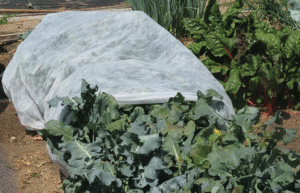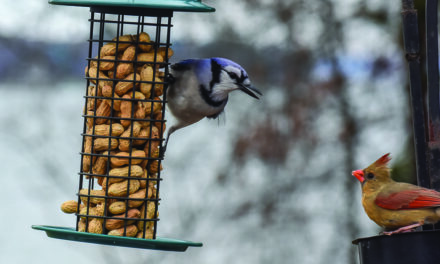
A floating row cover can utilize heavier fabric from 1.5- to 2.2-ounce weight adds an additional 4 to 10 degrees F of defense against frost damage, and allows between 50- and 70-percent light transmittance. (Photo courtesy North Carolina State University)
With temperate weather lasting well into October this year, did it seem a shame to put the vegetable garden to bed?
Were you tempted to keep right on growing, even as the air got crisper and the leaves continued to fall? Can you imagine serving freshly picked tomatoes or peppers for Thanksgiving?
If your answer to any of these questions was “yes!” floating row covers might just be your go-to gardening upgrade.
More people than ever are warming to the idea of using “garden blankets” to extend their growing season. Maybe you’ve seen white fabric splashed throughout backyards, schoolyards, and community garden sites.
Look closer — instead of leftover Halloween décor, you’re seeing floating row covers, which can add weeks and sometimes months to the growing season.
Sabine Harvey, Master Gardener and Horticulture Program Assistant with the University of Maryland Extension in Kent County, has been using row covers to grow vegetables at her family garden year-round for the past 10 years. She also uses row covers at the Kent County Middle School garden, which began in 2010.
According to the “School and Community Gardens in Kent County” Facebook page, a middle school teacher realized how many of the students relied upon additional food supplies from the local food pantry as well as other organizations.
“We started a school garden to give students more access to fresh produce. The garden is now part of the seventh grade curriculum,” one of the group’s posts said. Local Master Gardeners provide maintenance and programming support.
A photo of the school’s garden swathed in tunnels of white is featured in Extension Publication GE 004, which supplies user friendly information on what floating row covers are made from, how they help prolong the growing season, plus DIY tips on how to make and install them.
Here’s a summary to get you started:
What is it made from?
• White, light, nonwoven polypropylene (spunbonded polyester) in a variety of thickness and sizes which growers can customize to suit their needs
• Translucent gauzelike appearance, resembling “interface material used in sewing”
What does it do?
• Protects against frost & wind, acts as barrier to bugs and other pesky munchers
• Lets in light, air, and water
• Inexpensive (no more than a few cents per square foot)
• Reusable for several years
• Raises temperature and humidity to help spring and fall seedlings grow faster
• Simple to set up using easily accessed materials
Where can I purchase?
• Known as reemay, agribon, garden quilt, or harvest guard, just to name a few, FRC material is widely available for purchase from seed catalogs and garden centers and online.
The lightest thickness of FRC at 0.05 ounces, promoted mainly to guard against insects, nevertheless can protect plants up with 2 to 6 degrees F protection against frost. This type of protection is important as insects aren’t only a problem during the hot weather months, Harvey cautioned.
“A lot of our cold weather crops (leafy greens) are in the cabbage family and they are plagued by a number of pests. The pests are more abundant in late season than in early spring,” Harvey said.
Heavier fabric from 1.5 to 2.2 ounce weight adds an additional 4 to 10 degrees F defense against frost damage, and allows between 50 and 70 percent light transmittance.
The National Resources Conservation Service of USDA suggests doubling thin layers for a few more degrees of warmth but also cautioned that each layer reduces light filtering in from 10 to 12 percent.
You may wonder how long a row cover can keep you in the growing business.
Harvey has used heavier plastic fabric to continue the season into December and even January at her home and the school.
“Floating row covers can only protect crops from cold temperatures for so long,” Harvey said. “We have actually gotten some low tunnel hoops for the garden. What we will do when it gets really cold is put the floating row cover directly on the vegetables and put plastic over the hoops. That way we have created a double layer of insulation.
“The only caveat is that you do need to (partially) remove the plastic on the warmer days in the winter otherwise you will cook your crops.”
Row covers can drape directly atop some plants (allowing for a bit of slack) to push up as growth occurs.
But for greatest protection of tender shoots, configuring simple low hoops allows for added aeration and safely keeps tender vegetation from meeting frosty fabric.
In either case, it’s crucial to anchor the fabric solidly to the ground to prevent insects from entering and taking advantage of the perfect breeding conditions to wreak havoc on your intended harvest. You choose to use landscape pins or sod staples, but sturdy bricks, rocks, soil and wood, including tomato stakes, also work.
Helpful Hints for FRC:
• Floating Row Covers help weeds grow faster. Hand weed regularly or lay down mulch at the outset
• You can water through FRCs resting atop plants; with hoops, lift fabric and water directly on plants
• When not in use, store covers indoors in bags or other secure containers — not in barns or other “out” buildings where mice may nest.





